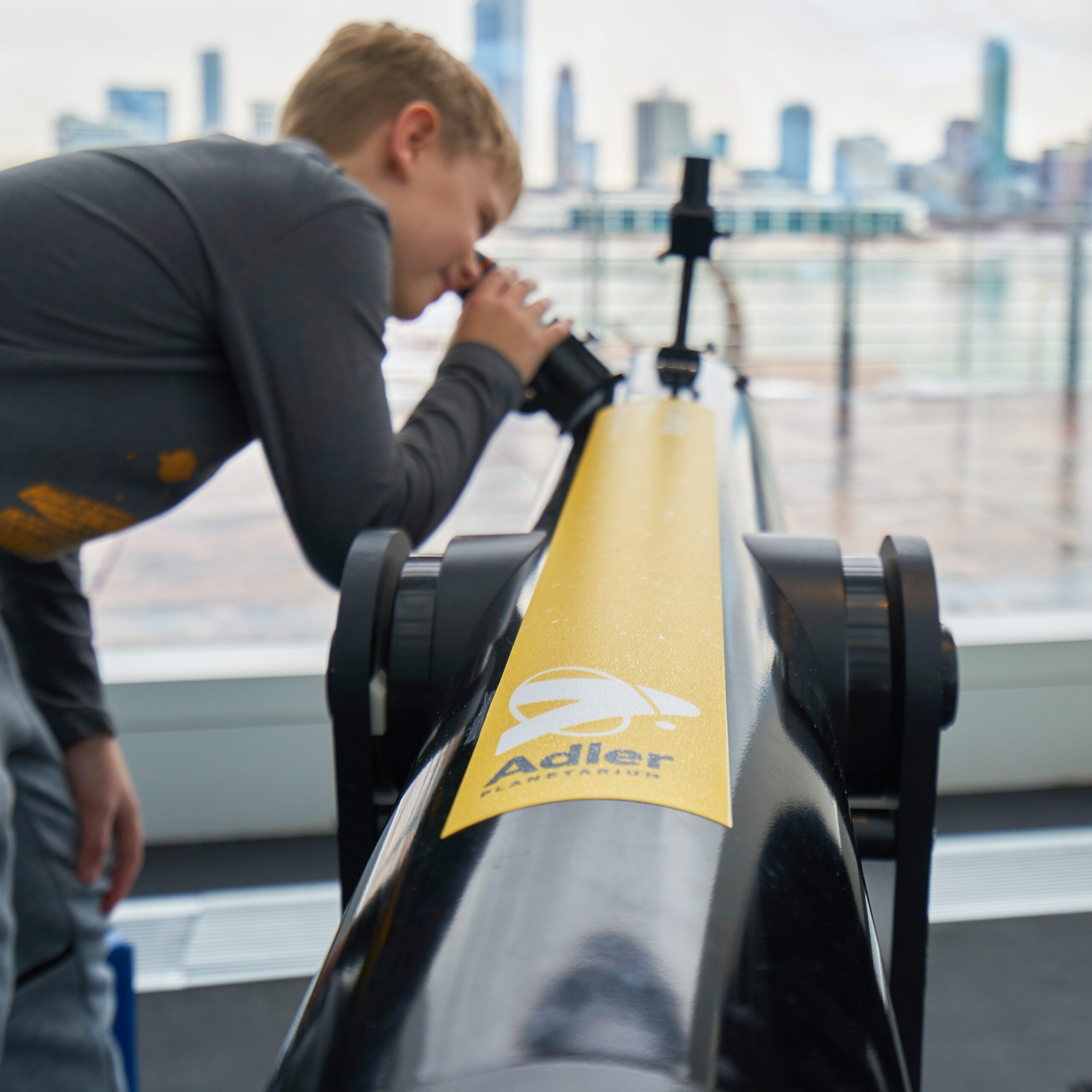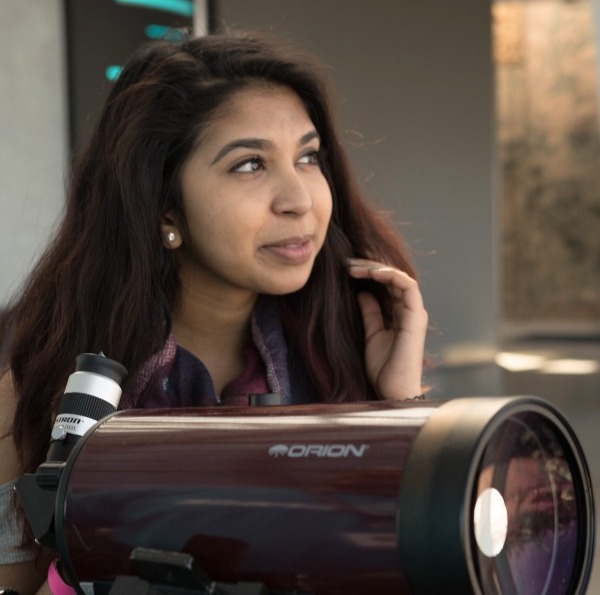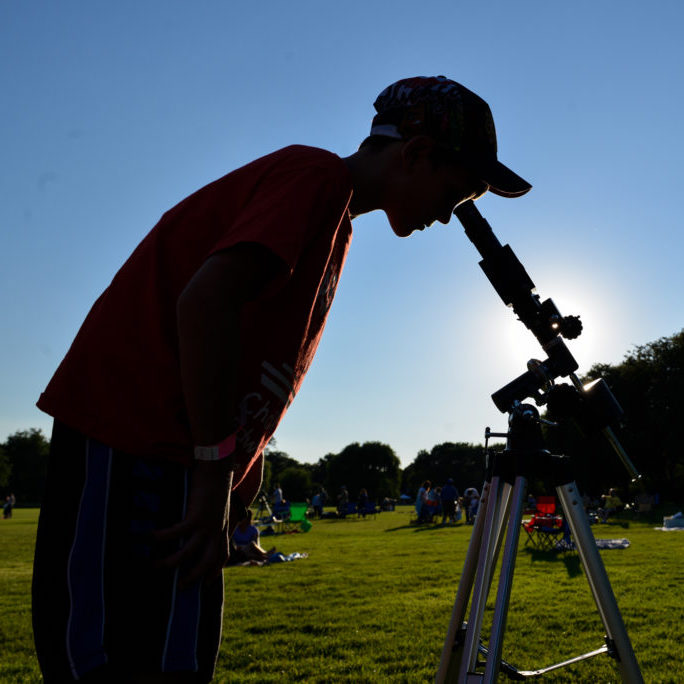Choosing A Telescope

Header Image: Looking through a telescope at the Adler Planetarium.
Editor’s Note: This blog was originally published in August 2020 and was updated in August 2024 with more current information.
One question we often get at the Adler is: “I’m a beginner. What’s the best telescope for me?”
The really short answer is, “The best telescope for you is the one you will actually use!” But the long answer can get more complex. So before we dig in, first we’d just like to say welcome to the wonderful world of skywatching! We’re so excited that you’re interested in purchasing a telescope to further your night sky observing adventures. To help get you started, we put together this little guide to help you navigate your first telescope purchase.

Before You Buy A Telescope, Get To Know Your Sky!
A good thing to remember before you purchase a telescope is that a telescope doesn’t necessarily make it easier to find things in the nighttime sky. When you look through a telescope, you are looking at a much smaller piece of sky than with your eyes alone. And the larger the telescope is the smaller the piece of sky is that you may be looking at. It is really important to learn about the sky and how to find different objects, like planets, stars, and more. Here are a handful of options to get you on your way.
- Download a mobile phone sky app. Examples include Sky Safari, Night Sky (iOS), or Stellarium (iOS and Android). These apps turn your phone into a personal planetarium, and the labels tell you exactly what you see when you look up at the stars. Pro tip: Adler staff use apps, too!
- Read 365 Starry Nights by Chet Raymo. This handy reference gives you something new to learn in the sky every night of the year.
- Consider buying a pair of binoculars before diving into a telescope purchase. They are very portable, you can use them in the daytime or at night, they show an upright image, they allow you to use both eyes, and you can scan the sky quickly to find bright nighttime objects. Aim for binoculars labelled as 7×35, 8×40, or 10×50, or similar. The first number is the magnification (7x, 8x, 10x), so a higher first number means higher magnification. The second number is the diameter of the main lenses of the binoculars in millimeters, so as that number increases, the more light the binoculars gather & the brighter the image will be. Binoculars are also a great option for younger children as they start to get used to the skill of looking through lenses, rather than looking at them. If you are tempted to go REALLY big (12×80), you’ll probably need a tripod because the bigger your binoculars are, the heavier they are, and the harder they are to hold and easily use.
- Your local library may have telescopes and binoculars for checkout. This is a great way to try before you buy!
- Attend a Sky Observers Hangout program or tune-in to our Skywatch Wednesday YouTube series. Learn about objects in the sky and where to find them with Adler experts!
- Attend an amateur astronomy club meeting or skywatching night. There are astronomy buffs just like you all over the world!
- And most importantly, temper your expectations for your first telescope. While we are all “wowed” and amazed by images from the Hubble Space Telescope (HST), we have to remember that it is a multi-billion dollar telescope with incredible capabilities. A beginner’s telescope won’t show HST-quality images. But a beginner’s telescope will start to give you a direct connection to the sky.
Ok, Ready To Buy Your First Telescope?
Once you get a handle of the basics of navigating the night sky, you’re ready to make your telescope purchase. Here are some things to consider.
First, do not be drawn to the cheapest telescope you can find. Remember, you get what you pay for. Avoid telescope advertisements that put the magnification number first and foremost in the ad. A telescope that touts its magnification as its main draw might have poor optics, a shaky mount, or other drawbacks. Stick to manufacturers who have experience catering to beginners such as yourself.
Examples of telescope manufacturers include Apertura, Celestron, Sky-Watcher, Explore Scientific, Vaonis, Zhumell, ZWO, and others.
Beginner Telescopes
Telescope sizes are given as the diameter of the main mirror or lens. Good beginner telescope sizes range from 4.5” to 6” (100 mm to 150 mm).
- Examples of specific telescopes: Celestron Signature Series FirstScope 76mm, Zhumell Z114 and Z130 portable altazimuth reflector telescopes (tabletop models), Sky-Watcher Heritage 150 Tabletop Dobsonian, Sky-Watcher Classic 150P Dobsonian
- For a first time telescope, expect prices in the $200 to $500 price range. One exception is the Celestron Signature Series FirstScope 76mm, which you can typically find for less than $100. This is a smaller telescope than the others mentioned above (about 3 inches/76 mm in diameter), but if affordability is your key point over light gathering ability, this is an option.
Medium-Level Telescopes
If you’re looking for something larger, good medium-level telescopes range from 6” to 8” (150 mm to 200 mm) in size.
- Examples of medium-level telescopes: Apertura AD8 Dobsonian 8″ Telescope, Sky-Watcher Classic 200P Dobsonian, Sky-Watcher Flextube 200P Collapsible Dobsonian, Celestron StarSense Explorer 114mm or 130mm Tabletop Dobsonian Telescope, Celestron StarSense Explorer 8″ Smartphone App-Enabled Dobsonian Telescope, Celestron StarSense Explorer LT 114AZ and 130 AZ Smartphone App-Enabled Newtonian Telescopes
- For medium-level telescopes, you can expect to pay in the $300 to $800 price range.
Advanced-Level Telescopes
Advanced telescopes can help you find and track objects in the sky. However, we don’t usually consider these as a beginner’s option because you may still need to know what the telescope is looking at in order to properly align it for viewing. The price can also be a deterrent as they are generally 3x-5x more costly than comparably-sized, non-computerized telescopes.
- Examples of these types of telescopes include the Celestron NexStar 6SE or 8SE, and the Celestron NexStar Evolution 9.25
- An additional type of telescope that is somewhat-new to the market is the so-called “smart telescope,” which is a telescope that specializes in astro-imaging, not eyepiece viewing. An example of this type of telescope is the ZWO SeeStar S50 Smart Telescope. Other examples include the Vaonis Vespera Pro Smart Telescope.
- Advanced tracking telescopes start at around $800 and run into the thousands of dollars. Smart telescopes start at around $500 and run into the thousands of dollars.
Before you purchase, it’s always best to do your homework. We recommend reading reviews and buying from a vendor with a service team that can answer any questions you have before and after you buy. If possible, don’t just buy from the vendor giving you the lowest price. Spending slightly more from a truly great vendor who gives you memorable customer service is usually worth the extra cost.
Taking these precautions and extra steps will help ensure the best possible experience!

What Are You Waiting For? Go Explore!
Now that you’ve got your telescope, it’s time to get out there and explore our universe! What will you see? Craters on the Moon? Moons of Jupiter? Or even the rings of Saturn? The possibilities are astronomical!
Here are a couple of guides to help you get started on your new observing adventure:
Join Our Community Of Stargazers Online
Chat with astronomy educators Michelle Nichols and Hunter Miller about what to look up at and observe in our night sky! During Sky Observers Hangout episodes on our YouTube channel, we show you how to find celestial objects, discuss upcoming celestial events, and more. Watch the recap of Sky Observers Hangout: How To Choose A Telescope and subscribe to our channel for reminders about new events.
Happy skywatching!
—
Note: The telescope models and manufacturers listed above are examples only. This is not an exhaustive list and these telescope models and manufacturers are not necessarily recommended by the Adler Planetarium. The prices given were accurate at the time of this article’s initial publication. Choose telescopes and accessories that are right for your personal situation. The Adler assumes no liability or responsibility from the use or misuse of the information in this article.






